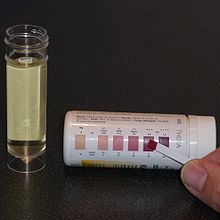Keto body
| Keto bodies (examples) |
|---|
 acetone |
 3-ketobutyric acid |
 ( R ) -3-hydroxybutyric acid β-hydroxybutyric acid |
Ketone body or ketone bodies is the collective name for three compounds , mainly in catabolic documents (ie hunger, reducing diet or low carbohydrate diet) are formed and possibly create a ketosis lead. Keto bodies include acetoacetate (also called acetoacetate), acetone and β-hydroxybutyrate or 3-hydroxybutyrate . The latter connection is the most important of the three.
The ketone bodies are made in the liver from acetyl-CoA , which comes from β-oxidation . They represent a transportable form of acetyl-CoA in the human body. In order to utilize the ketone bodies, however, the brain and muscles first have to adapt by expressing enzymes that are needed to convert keto bodies back into acetyl-CoA. In times of hunger, the keto bodies make a considerable contribution to energy production. After a while, the brain is able to get by on 40 grams instead of 120 grams of glucose per day.
Metabolism of the Keto Bodies
Ketogenesis
The synthesis of the keto body takes place from two molecules of activated acetic acid, acetyl-CoA , the normal intermediate product of the breakdown of fatty acids . First, with the help of acetyl-CoA-acetyltransferase, acetoacetyl-CoA is formed, which with the use of another acetyl-CoA unit and the enzyme HMG-CoA synthase to the intermediate product 3-hydroxy-3-methylglutaryl-CoA (HMG-CoA ) is extended. Finally, the HMG-CoA lyase cleaves the acetoacetate. These three steps take place exclusively in the mitochondria of the liver ( Lynen cycle ). 3-Hydroxybutyrate is finally produced in the cytosol by the D- β-hydroxybutyrate dehydrogenase .
HMG-CoA is also an end product when the amino acid leucine is broken down , while acetoacetate is produced when the amino acids phenylalanine and tyrosine are broken down .
Acetoacetate turns into acetone through spontaneous decarboxylation ; it is occasionally noticeable in the breath of diabetics and dieters. The body can only use it to a limited extent for gluconeogenesis . The proportion of acetone in the keto bodies is, however, low.
Metabolism
Acetoacetate can be obtained from D- β-hydroxybutyrate by means of the enzyme 3-hydroxybutyrate dehydrogenase; the reaction is easily reversible. The 3-keto acid-CoA transferase transfers CoA to acetoacetate, while simultaneously releasing succinate . Ultimately, acetyl-CoA is obtained twice from acetoacetyl-CoA and CoA; this reaction is catalyzed by acetyl-CoA-acetyltransferase , which is also the reverse of a reaction that takes place during the synthesis.
This activation of the keto bodies takes place in the mitochondrial matrix of all cells that can process keto bodies, but not in the liver. Finally, the acetyl-CoA obtained in this way flows into the citric acid cycle , where it is oxidized to generate energy.
Keto Bodies and Diabetes
When type 1 diabetes mellitus (diabetes) is found in absolute insulin deficient increased ketone bodies in urine ( ketonuria ). This is due to too high a concentration of them in the blood. Like glucose, the kidney secretes the keto bodies when the blood concentration is increased.
The reason for the increased production of the ketone bodies is the lack of insulin: Although there is actually enough glucose in the blood, it can not get into the cells without the insulin as a transporter . Therefore, despite the increased blood sugar level in the cells, there is a glucose deficiency. This leads to the breakdown of fat ( lipolysis ) for energy production. While insulin inhibits the breakdown of depot fat, a lack of insulin promotes fat breakdown, lipolysis. Lipolysis induced by low insulin levels is typical of starvation metabolism. Ketone bodies are formed when the breakdown product of the fatty acids, acetyl-CoA, cannot enter the citric acid cycle due to an insufficient oxaloacetate concentration. Oxaloacetate can be synthesized from pyruvate in an anaplerotic reaction . Pyruvate is the end product of glycolysis. The low glucose level in the cells in the case of diabetes mellitus leads to small amounts of pyruvate and thus to small amounts of oxaloacetate, which promotes the formation of ketone bodies from acetyl-CoA. If there are too many keto bodies in the blood, their pH value drops and ketoacidosis occurs , which in the worst case leads to a ketoacidotic coma. This is why ketoacidosis usually only occurs in type 1 diabetes mellitus, as there is an absolute insulin deficiency. In type 2 diabetes with a relative insulin deficiency, the body has developed insulin resistance , which means that more insulin is produced. This, albeit reduced, action of insulin enables the body to avoid the formation of ketone bodies.
A typical symptom of ketosis is the smell of acetone ( nail polish remover ) in the air, as the ketone bodies are exhaled through it.
In the case of persistent hypoglycaemia with a simultaneous decrease in the number of keto bodies in the blood, however, the presence of a fatty acid oxidation disorder must be considered. An example of this is a medium chain acyl-CoA dehydrogenase deficiency .
literature
- Berg / Tymoczko / Stryer: Biochemistry . 5th edition, Spektrum Akademischer Verlag GmbH, Heidelberg 2003, ISBN 3-8274-1303-6 .
Web links
- Gopinathrao / reactome.org: Ketone body metabolism doi : 10.3180 / REACT_1861.2
Individual evidence
- ↑ JP Casazza, ME Felver, RL Veech: The metabolism of acetone in rat . In: The Journal of Biological Chemistry . tape 259 , no. 1 , January 10, 1984, ISSN 0021-9258 , pp. 231-236 , PMID 6706932 .


